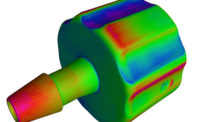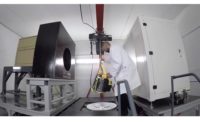NDT | Computed Tomography
Revolutionizing Manufacturing: The Growing Trends of Industrial CT Scanning
The adoption of industrial CT scanning has transformed product development, manufacturing, and delivery cycles across various industries.

A CT Machine interior. All Images Source: Nel PreTech Corp.
In the field of manufacturing, precision, accuracy, and efficiency stand as fundamental pillars crucial for achieving optimal performance and success. Traditional metrology methods have long been the bedrock of ensuring quality control and product integrity. However, with the advent of industrial CT (computed tomography) scanning, a revolution is underway in how manufacturers approach inspection and quality assurance. This cutting-edge technology is rapidly gaining traction, offering a myriad of benefits and advantages over older methods, and reshaping the landscape of product development and manufacturing cycles.
Understanding Industrial CT Scanning
Industrial CT scanning, often referred to as 3D X-ray scanning, is a nondestructive testing (NDT) method that utilizes X-ray equipment to produce detailed three-dimensional representations of a scanned object’s external and internal structures. The process involves capturing a series of X-ray images from different angles and reconstructing them using advanced algorithms to create a precise 3D model of the object. This allows for thorough inspection of both internal and external features without the need for disassembly, preserving the integrity of the part.
Benefits Over Traditional Methods
- Comprehensive Inspection: Unlike traditional methods such as coordinate measuring machines (CMMs) or visual inspection, industrial CT scanning provides comprehensive insights into both exterior and interior features of complex components, including voids, defects, and internal structures. In other words, CT scanning results in a complete surface map of a product. In comparison, traditional CMM/vision inspection produces a limited number of discrete data points.
- Nondestructive Testing: One of the most significant advantages of CT scanning is its nondestructive nature. Manufacturers can inspect parts without causing any damage, enabling quality control without compromising the integrity of the components.
- Time and Cost Efficiency: CT scanning significantly reduces inspection time compared to traditional methods. Virtually every step of a metrology driven CT inspection can be automated. This includes scan data reconstruction, measurement program execution, data population, and test report creation. One of the most striking comparisons between traditional test methods and 3D scanning is measurement programs that run on digital scan data execute hundreds of measurements in seconds or minutes. Traditional measurement can take hours or days. Moreover, it eliminates the need for costly and time-consuming disassembly, saving resources and accelerating the production process.
- High Accuracy and Resolution: With advancements in software capabilities and computing power, industrial CT scanners offer unparalleled accuracy and resolution, allowing for precise measurements and analysis of even the smallest features. Measurement uncertainties on CT scanners are proven and equally comparable to traditional measuring tools for a wide range of material types and product sizes.
- Digital Data Remains Indefinitely: The electronic storage of scans allows for immediate access for further and continued analysis without the need for costly part setups and remeasurement.
- The Power of Visualization: Traditional inspection of manufactured parts relies for the most part on numerical data and spreadsheets of information. The visualization of manufactured part conditions allows for quicker assessment and to some extent reduces the skill sets required for data interpretation (such as the need for advanced Geometric Dimensioning & Tolerancing knowledge (GD&T)). In fact, what we are seeing is that many industries are purposefully reducing the sheer number of dimensional callouts and GD&T on product design prints and substituting general surface profile controls within the notes sections of the design prints. This reduces the metrology burden and simplifies the analysis.
Advancements in Software and Computing Power
Recent advancements in software capabilities and computing power have played a pivotal role in accelerating the acceptance and utilization of industrial CT scanning in the manufacturing industry. Enhanced algorithms enable faster reconstruction of CT images and improved visualization of complex structures. Additionally, the integration of artificial intelligence and machine learning algorithms facilitates automated defect recognition and analysis, further streamlining the inspection process and enhancing accuracy.

Dramatic Impact on Product Development and Manufacturing Cycles
The adoption of industrial CT scanning has had a transformative effect on product development, manufacturing, and delivery cycles across various industries.
- Improved Quality Control: By enabling thorough inspection of components at various stages of production, CT scanning ensures adherence to stringent quality standards, reducing the likelihood of defects and minimizing costly rework or recalls.
- Accelerated Prototyping: CT scanning facilitates rapid prototyping by providing detailed insights into the performance and integrity of prototype components. Manufacturers can quickly identify and rectify design flaws, expediting the development cycle and reducing time-to-market.
- Enhanced Component Analysis: In industries such as automotive and aerospace, where safety and reliability are paramount, CT scanning allows for in-depth analysis of critical components, ensuring compliance with regulatory requirements and mitigating risks associated with component failure.

Streamlined operational efficiency and improved service to the organization.
In the past, testing, metrology, and analysis operations were confined to the quality department. Quality technicians and engineers would maintain sole responsibility and skill sets for executing automation and testing. They would disseminate test reports and analysis to the other functions of the operation. Tooling engineers/managers, process engineers, design engineers, and project managers would in turn start their own analysis of the results. This would often lead them to return more questions to the quality department. The quality department would investigate further and the whole cycle would start over. This would perhaps continue for multiple iterations before any definitive conclusions were reached or any meaningful action was taken. Nowadays, organizations are increasingly arming every department with 3D visualization and analysis software and building skill sets throughout the various departments. In this way, everyone can be working on the analysis concurrently from the perspective of their own job responsibility. It also allows for a better collaborative process between the departments which accelerates project timelines. The difference is transformative and the return on investment is staggering according to many top industry leaders.
Case Studies and Data
A study conducted by the National Institute of Standards and Technology (NIST) found that the use of industrial CT scanning resulted in a 50% reduction in inspection time compared to traditional methods, leading to a 30% increase in manufacturing efficiency.
In another case study conducted by a leading aerospace manufacturer, the implementation of industrial CT scanning reduced the rejection rate of critical components by 75%, resulting in substantial cost savings and improved product reliability.
Outsourcing CT scanning to accredited test labs offers several benefits to manufacturers
Some organizations may not have the opportunity or resolve to take on the large capital expenditure and continued operational costs of CT scanning equipment and the high-level personnel required to operate it effectively. The good news is that there are options. An organization can still develop the analysis expertise described above and rely on outsource test labs to execute scans. The benefits here can also be transformative.
- Cost Savings: By outsourcing CT scanning services, manufacturers can avoid the high capital expenditures associated with purchasing and maintaining CT scanning equipment. Additionally, outsourcing eliminates operational expenses related to staffing, training, and facility maintenance, allowing manufacturers to allocate resources more efficiently.
- Access to Expertise: Accredited CT scanning test labs employ highly skilled technicians and engineers with expertise in CT scanning technology and interpretation of results. Manufacturers can leverage this specialized knowledge to ensure accurate and reliable inspection of their components, without the need to invest in extensive training or hiring additional personnel.
- Flexibility and Scalability: Outsourcing CT scanning allows manufacturers to scale their inspection capabilities according to fluctuating demand, without being constrained by the limitations of in-house equipment. Test labs can accommodate varying project sizes and timelines, providing manufacturers with flexibility and agility in managing their inspection requirements.
- Quality Assurance and Compliance: Accredited CT scanning test labs adhere to strict quality standards and regulatory requirements, ensuring that inspection processes are conducted with the highest level of accuracy and reliability. Manufacturers can have confidence in the integrity of the inspection results provided by reputable service providers, thereby mitigating risks associated with product defects or non-compliance.
Overall, outsourcing CT scanning to accredited test labs offers manufacturers a cost-effective and efficient solution for meeting their inspection needs while maintaining focus on core business activities. As the demand for NDT services continues to grow, outsourcing is poised to become an increasingly popular strategy for manufacturers looking to optimize their operations and enhance product quality.
Conclusion
Industrial CT scanning represents a paradigm shift in the manufacturing industry, offering unparalleled capabilities in inspection, analysis, and quality assurance. With its nondestructive nature, high accuracy, and efficiency, CT scanning is poised to become the cornerstone of modern manufacturing processes. As advancements in software and computing power continue to evolve, the widespread adoption of industrial CT scanning is inevitable, paving the way for a new era of innovation and excellence in manufacturing.
Manufacturers seeking to mitigate the high capital expenditures and operational expenses associated with CT scanning have a viable alternative in outsourcing to accredited CT scanning test labs. These specialized facilities offer comprehensive CT scanning services on a contract basis, allowing manufacturers to access cutting-edge technology and expertise without the need for significant investment in equipment and infrastructure.
According to a report by MarketsandMarkets, the global market for nondestructive testing (NDT) services, including CT scanning, is projected to grow significantly in the coming years. This growth is driven by the increasing demand for outsourcing NDT activities to specialized service providers, particularly in industries such as aerospace, medical, automotive, and electronics manufacturing.
Looking for a reprint of this article?
From high-res PDFs to custom plaques, order your copy today!




